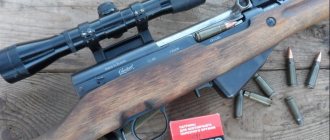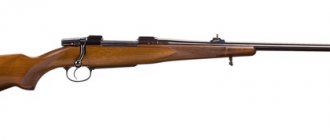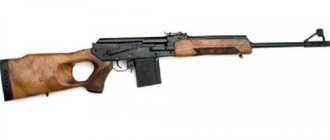Definition
A rifle is a small rifled weapon that has a butt to rest on the shoulder when shooting. The first screw guns appeared in the century before last; they became a replacement for the musket - a weapon that was distinguished by imprecise aiming and a heavy barrel. Rifles were used in the First and Second World Wars, and it was during these periods that they began to be manufactured in all countries. Nowadays the rifle is widely used by hunters; permission to store it is required.
Dragunov sniper rifle
A carbine is a lightweight version of a rifle with a shortened barrel. This type of firearm has become an excellent alternative to its predecessor due to its low weight. But due to its reduced size, the carbine is inferior in many respects to the rifle. Without official registration, these weapons are unacceptable for use.
Small-caliber carbine "Yastreb"
Application
The cavalry carbine, whose technical characteristics were superior to many foreign competitors, was actively used from the moment of its creation until the end of the Great Patriotic War. In addition, its export and revised versions were in service with the armies of Bulgaria, Poland, Germany, and Finland. After the creation of the Balkan Union, over 50 thousand modifications were delivered to the Bulgarian army. In Poland, analogues were produced under the WZ label. Since 1943, these rifles were armed with the infantry regiment of the first Polish division. During the Third Reich, guns were called Gewehr. The Finns positioned the modernized versions of Mosin carbines as M-24/27/29.
Comparison
The main difference between the rifle is the large barrel size. The weapon has more weight and is quite difficult to use. The carabiner, on the contrary, is quite compact, which allows you to use it for a long time without unnecessary strain in your hands and stress on your shoulders.
If you take a classic rifle, it is designed for only one cartridge, after which it needs to be reloaded. The carbine has a magazine for several shots. But if we take into account modern types of rifles, then in this they are no different from their counterparts.
The carbine has additional accessories, for example, a bayonet. During the war, such weapons made it much easier for soldiers to perform various tasks. And in the absence of cartridges, they could neutralize enemies not only with a butt, but also with a knife. This is also a definite plus when hunting.
The rifle is capable of shooting at a greater distance. A fired bullet can travel a distance of 2000 meters. Of course, this is not very useful when hunting, since a person will not see the target at such a distance. However, from a distance of 200 meters the blow will be very powerful, even a huge bear cannot resist it. The carbine does not have this ability. Bullets can travel a maximum distance of 800 meters. Accordingly, when shooting at 200 meters, it is not always possible to kill the victim the first time, if we are talking about large animals. If you hunt small animals or birds, then one bullet will be enough.
A rifle is more expensive than a carbine, despite its inconvenience to use. But only this type of weapon is suitable for experienced hunters. Especially if the gun is used for large animals. For small hunting, a carbine is sufficient. In addition, due to the large number of options presented, it is much easier to choose.
Legal issues[edit]
United States[edit]
Under the National Firearms Act of 1934, a firearm with a stock or originally manufactured as a rifle and a barrel less than 16 inches (410 mm) in length is classified as a shotgun. The restrictions on the use of short-barreled rifles are similar to the restrictions on the use of short-barreled shotguns, requiring payment of a $200 tax before production or transfer - a process that can take several months. Because of this, firearms with a barrel less than 16 inches (410 mm) and a shoulder stock are rare. A list of firearms that are not subject to NFA due to their antique status can be found here [13] or due to their Curio and Relic
can be found here; [14]These lists include a number of rifles with a barrel shorter than the minimum permissible length and firearms that are "primarily collector's items and are unlikely to be used as weapons and are therefore excluded from the provisions of the National Firearms Act." Machine guns, as their own class of firearms, are not subject to the requirements for other classes of firearms.
Unlike simple shoulder stock kits, carbine conversion kits are not classified as short rifles. By replacing the pistol barrel with a barrel of at least 16 inches (410 mm) in length and an overall length of at least 26 inches (660 mm), the carbine-converted pistol may be considered a standard rifle under Title I of the Weapon Control. Act 1968 (GCA). [15] However, some Mauser C96, Luger, and Browning Hi-Power Curio & Relic "Broomhandle" pistols with only the originally issued stock included may retain their pistol classification.
Carbines without a stock and not originally manufactured as a rifle are not classified as rifles or shotguns. A carbine manufactured less than 26 inches (660 mm) in length without a front vertical grip will be a pistol and, notwithstanding state laws, may be concealed without making any other weapon unregistered. A virtually identical carbine with an overall length of 26 inches (660 mm) or larger is simply an unclassified firearm under Title I of the Gun Control Act of 1968, since all other weapons only apply to firearms under 26 inches (660 mm). mm) or hidden. However, a modification designed to fire from the shoulder and circumvent the short-barreled rifle regulations is considered illegal to possess and manufacture an unregistered short-barreled rifle.
In some historical cases the term " machine gun"
was the official name for submachine guns such as the British Sten pistols and Australian Owen pistols.
The semi-automatic version of the Sterling submachine gun was also officially called a "carbine". The original Sterling semi-automatic would have been classified as a "short-barreled rifle" under the United States National Firearms Act, but fully legal long-barreled versions of the Sterling were created for the US collector market. [ citation needed
]
Carbine: types, purpose, characteristics, features
Hunters are a fastidious people. When hunting, some are ready to be content with a single-barreled shotgun, others with a smooth-bore double-barreled shotgun, and for others, give them a more powerful and impressive hunting weapon - a carbine. Especially if the hunter wanted to try his hand at hunting some big game. It is clear that in this case a shotgun is not enough. Here you will need a more impressive weapon. For example, a hunting rifle.
A carbine is the same rifle. Compared to a classic rifle, the carbine's barrel is shortened, and the carbine also differs in some specific design features. The barrel of the carbine is not smooth, but rifled (although in some versions it can be smooth). As for the size of this type of weapon, the length of the carbine is usually less than the length of its “progenitor” - the classic rifle.
Purchasing a carbine is a difficult and troublesome task. Currently, there is an almost endless list of carbines (rifles) of both Russian and foreign production. It is very important to decide which carbine is the best - that is, the most suitable for a particular hunter and for hunting a particular game.
Further reading[edit]
- Beard, Ross E. Carbine: The Story of David Marshall Williams
. Williamstown, NJ: Phillips, 1997. ISBN 0-932572-26-X OCLC 757855022 - Carbines: cal.
.30 carbines M1, M1A1, M2 and M3 . Washington, DC: Headquarters, Departments of the Army and Air Force, 1953. - Macaulay, John D. Carbine on the Civil War, 1861–1865
. Union City, TN: Pioneer Press, 1981. ISBN 978-0-913159-45-3 OCLC 8111324 - Macaulay, John D. US Cavalry Carbine, 1861–1905
. Lincoln, RI: Andrew Mowbray Publishers, 1996. ISBN 0-917218-70-1 OCLC 36087526
Hunting rifles and their calibers
All carbines are strictly divided according to their calibers. In this case, the smaller the barrel caliber, the lower the price of the weapon itself. However, the price comes at a price, but when choosing a carbine, you must first of all proceed from the size of game the hunter intends to hunt. So, the calibers:
- Carbine chambered for 5.6x39 caliber. Cartridges of this caliber are usually used to hunt all kinds of small animals. This is what is called a gentle cartridge. With a skillful shot with such a charge, the animal’s skin remains unspoiled;
- Carbine chambered for 7.62x39 caliber. Such charges are fired from the Saiga carbine and similar models. Charges of this caliber are inexpensive, and they can be used to shoot medium-sized game (wolf, wild boar, roe deer). However, these cartridges have little stopping power;
- Carbine chambered for 5.6x45 caliber cartridges. This is a relatively small caliber, and with such charges you can catch fur and feathered game;
- Carbine chambered for 7.62x51 caliber cartridges. A very impressive and serious caliber. Such charges can hit large game from long distances;
- Carbine chambered for 30-06-m cartridges. This is the largest caliber. Charges of such calibers are used to hunt the largest game: bears, moose, large wild boars. The weight of a bullet in cartridges of this caliber is about 14 grams. You can find a lot of versions of weapons adapted to fire charges of similar calibers. However, it should be borne in mind that such cartridges are quite expensive.
There are also small-caliber carbines that fire charges smaller than 5.6x39. This is a specific caliber: it is used only for sporting purposes and for commercial hunting.
Content
- 1 Etymology
- 2 History 2.1 Carbine arquebus and musket
- 2.2 Carbine
- 2.3 World wars
- 2.4 After World War II
- 3.1 Modern armed forces
- 5.1 Shoulder-stock pistol
- 6.1 USA
Sight for carbine
A carbine is a weapon designed to shoot over long distances, and you can shoot effectively over long distances only if you have an optical sight on your weapon.
Buying a scope is not such a simple matter. All scopes include two main characteristics called magnification and viewing angle. Both must be selected according to the values of their parameters. The best sights are those with high parameter values. It is clear that such scopes are somewhat more expensive, but with a good scope, hunting will be much more successful.
Links[edit]
- "Carbine". Dictionary.com
. Retrieved October 8, 2014. - Jump up
↑ Chisholm, Hugh, ed.
(1911). "Carbine". Encyclopedia Britannica
(11th ed.). Cambridge University Press. - "Carbine". Merriam-Webster Online Dictionary
. Retrieved September 26, 2022. - ^ ab "Carbine". Oxford English Dictionary
. - "Carbine". Online Dictionary of Etymology
. Retrieved September 26, 2022. - "Carbine". American Heritage Dictionary of the English Language
(Fifth ed.). Houghton Mifflin Harcourt. 2016. Retrieved September 26, 2022 - via thefreedictionary.com. - ↑
Black, Jeremy, Cambridge Illustrated Atlas, Warfare: Renaissance to Revolution, 1492-1792, (Cambridge University Press: 1996). - Jump up
↑ Pritchard, Russ A. (August 1, 2003). Weapons and equipment of the civil war. Globe Pequot Press. pp. 49–41. ISBN 978-1-58574-493-0. - Skennerton, Ian (2007). Lee–Enfield
. Gold Coast QLD (Australia): Arms & Militaria Press. p. 90. ISBN 978-0-949749-82-6. - ↑
Sheehan, John (October 1, 2006).
"Battlefield Stickiness Driver: Model 1903 Springfield in World War I". Guns Magazine
. Retrieved April 22, 2015. - Wilson, Royce (May 2006). Jungle Fever is a Lee-Enfield .303 rifle. Australian Shooter Magazine
- ^ ab Gurwitch, Jeff (December 11, 2011). "Submachine Guns (SMGs): Superior to Modern Short Barreled Rifles (SBRs)/Sub-Carbines, or Still a Viable Close Quarters Combat/Close Quarters Combat (CQB/CQC) Tool?" . Protection Overview
. Retrieved September 26, 2022. - "List of Rarities or Relics - Updated March 2001 to May 2005." . Bureau of Alcohol, Tobacco, Firearms and Explosives
. Retrieved November 13, 2015. - "List of Rarities or Relics - Updated January 2009 to June 2010." . Bureau of Alcohol, Tobacco, Firearms and Explosives
. Retrieved November 13, 2015. - "ATF Rule 2011-4 Relating to Carbine Conversion Units". Bureau of Alcohol, Tobacco, Firearms and Explosives
. Retrieved November 16, 2015.
Zeroing a rifle for hunting
To get an idea of how a carbine shoots and how to eliminate shortcomings in shooting, you need to shoot the weapon. Shooting can be done in different ways.
The simplest method can be called the “grandfather’s” method. This is exactly how weapons were shot in ancient times. To do this, they pulled out the bolt, looked into the barrel and, what is called “by eye,” aligned the crosshairs with the target. It is clear that it was difficult to determine in this way how accurately the weapon fired.
Most carbine owners have always used the traditional zeroing method. In fact, this method is quite simple. Two targets are taken, which are placed at different distances: at a distance of 50 meters, and at a distance of 100 meters. First, shooting is carried out at the first target - to make sure how well the weapon shoots overall. Then you need to start the main shooting - at a target set at a distance of 100 meters. In general, the point of zeroing is to align the point where the bullet can hit with the crosshair of the sight. When zeroing with an optical sight, adjustments are made using special adjustment devices available on the optical sight.
The most famous examples of Russian and foreign carbines
Currently, you can find many different types, modifications and versions of carbines, both Russian and foreign made. Most of them have good design and excellent technical characteristics. Let's review the most famous examples of this type of weapon.
Let's start with Russian carbines. Here it should be said that Russian carbines are for the most part not original versions, but domestic military weapons converted to carbines. During the alteration, the carbines largely lost the qualities of their combat prototypes, so most of these alterations are suitable for hunting insofar as they are.
- TOZ-78. Small-caliber version of Russian-made carbines. This weapon is mostly used by commercial hunters and athletes during shooting competitions. The weapon has very modest technical characteristics, and therefore the price of this carbine is low;
- Carbine "Sable". Another carbine designed for firing small-caliber charges. However, in terms of its characteristics and qualities, it compares favorably with the previous model, so there is greater demand for it, and the price is correspondingly higher;
- Carbine "Vepr". It is considered perhaps the best carbine made in Russia. This is a smooth-bore semi-automatic weapon that can be used as a service and hunting weapon, as well as for self-defense. The basis for the production of this carbine was the Kalashnikov light machine gun. Currently, there are many versions of this weapon, which can fire charges of different calibers;
- Saiga carbine. This sample is designed on the basis of a Kalashnikov assault rifle, which is clearly visible from its design. However, despite its appearance, this semi-automatic machine has rather dubious characteristics: in particular, it has a lot of weight and poor accuracy of fire;
- Carbine "Tiger". The basis for its creation was the Dragunov sniper rifle. The carbine turned out to be too heavy and long, and, moreover, with low accuracy of fire.
However, recently quite successful domestic models of hunting carbines have appeared. In particular, such samples include Lobaev’s hunting rifle (carbine). To fire this semi-automatic, the original charge is used - 408CheyTac. With this charge, the carbine can fire at a distance of more than 2 km. At the same time, the shot accuracy of this carbine is the highest among all domestic analogues.
Let's move on to foreign samples. Here, as they say, there is room to roam. In other words, in terms of quantity and quality, foreign carbines today compare favorably with their Russian counterparts. Accordingly, their price is higher, but this is a separate issue. These are mostly semi-automatic, but occasionally there are also models that need to be reloaded after each shot.
- Carabiner "Tikka Master". A very good and reliable example of a foreign-made hunting weapon. Moreover, it is relatively inexpensive. Some experts argue that this carbine has a poor-quality magazine with a weak supply of cartridges. However, this almost does not prevent the weapon from being popular both abroad and among Russian hunters;
- Carbine "Benelli Argo". Lightweight, weighing a little more than 3 kg, a semi-automatic rifle with a set of magazines that can hold 2, 4 and 9 charges. A distinctive feature of this carbine is the ability to change barrels of one caliber to another;
- Carbine "Browning BAR II". This is a weapon with excellent performance and elegant design. The carbine is perhaps the most popular type of hunting weapon in Russia;
- Carbine "Sako 75". Such carbines have been known since 1946. The weapon has an excellent reputation, and its price is relatively low. There are many models of this weapon with different barrel calibers;
- Carbine "Mauser-98". Hunting weapons of this brand have been known since the pre-war years. The rifle has not lost its popularity to this day, especially since many modifications of this weapon have now been developed;
- Carbine "Blaser R93". One of the most versatile carbine models in the whole world, which is used for different types of hunting. At the same time, cleaning this weapon does not present any difficulties;
- Carbine "Voere-2185". This carbine has a wonderful action and filigree finish. There are many modifications of this brand of carbine for firing cartridges of various calibers. The cost of the weapon is low;
- Carbine "Marlin 336". This carbine is very ancient, dating back to 1889. That is, the first model of the carbine was released that year, but since then, despite the improvements, the rifle has remained almost unchanged. And yet, the carbine is one of the most popular types of hunting weapons to this day. American hunters claim that this rifle is the best for deer hunting;
- Carbine "Sauer 303". Who hasn't heard of weapons? The weapons of this company have been successful for many years. History claims that the best weapons from this company were desired gifts even for kings and presidents. This version of the carbine is, so to speak, a weapon for the elite. It has excellent characteristics and a wonderful design. Thanks to these qualities, as well as its name, this carbine is almost the most expensive in the world.
Description
Brief characteristics of the 1856 cavalry carbine:
- length - 1.34 m;
- weight - 4.4 kg without bayonet;
- ammunition - Minie expansion cartridge;
- rate of fire - two aimed salvoes per minute.
The design of the improved stock contributed to accurate firing. Foreign gunsmiths highly appreciated the combat capabilities of the new Russian weapons.
A couple of years later, the rifled model of 1856 was put into service with the entire domestic infantry. Controversies often arose around this rifle. Some officers believed that only sharp shooters should be provided with such weapons. Despite the fact that the conservatives partially managed to defend their point of view, the cavalry carbine was approved for all infantry in May 1858. True, the sight made it possible to fire at a distance of up to 600 meters, which artificially reduced the capabilities of the weapon. Among the modifications: a dragoon model with a barrel shortened by 76 millimeters, as well as a Cossack version, weighing 3.48 kilograms with a special protrusion instead of a trigger.
Atom, assault rifle, carbine. What is the difference? How do they differentiate?
Recently I witnessed an argument between two young people who were arguing about the classifications of various small arms. And I also wondered, indeed, what is the difference between a carbine and a rifle, and how to determine which is which, or how, for example, do they distinguish between assault rifles and machine guns, and is there any difference between them at all? There were various variations on the division of small arms into carbines and rifles, for example, there was an assumption that carbines are simply shortened rifles, and there was an option that carbines are self-loading rifles, while ordinary rifles need to be reloaded every time. And all this only led to even bigger questions, for example, what is the difference between self-loading rifles and automatic ones? Or is it the same thing? In general, this confused me too, and I decided to look for information about the classification of weapons on the Internet, and found out that it turns out there is a special GOST, which makes it clear the differences between all this division.
This GOST can be freely found on the Internet. GOST 28653-90 (https://docs.cntd.ru/document/1200015064).
And here's what I found about this:
Etymology[edit]
The name comes from its first users - cavalry units called "Carabiniers", from the French carbine
, [3] from Old French
carabin
(soldier armed with a musket), the origin of which is unclear.
One theory links it to an "ancient weapon
of war" called
a calabra
;
[4] another associates it with the medieval Latin Calabrinus
"Calabrian";
[4] [5] Another, less likely, is escarrabine
, the gravedigger, from the scarab beetle. [6]
TYPES OF SMALL WEAPONS
Weapon
Automatic/self-loading
Non-automatic small arms
Small arms in which all reloading operations are performed using the muscular energy of the shooter
Automatic small arms
Small arms with fully automated reloading
Self-loading small arms
Automatic small arms, the trigger mechanism of which allows only single firing
Single-shot small arms
Single-barreled small arms without a feed mechanism and with one chamber
Multi-shot small arms
Small arms with a feed mechanism or more than one chamber
Options
Below are the technical characteristics of Mosin cavalry carbines produced in 1938/1944:
- caliber (mm) - 7.62/7.62;
- weight without charges (kg) - 3.4/4.1;
- length without bayonet (m) - 1016/1016;
- trigger mechanism - impact type;
- aiming mechanism - front sight with sector sight;
- shutter - rotary longitudinally sliding;
- sighting range (mm) - 1000;
- bullet speed at start (m/s) - 816;
- food - integral clip for five rounds of ammunition;
- final years of production - 1945/1949.











